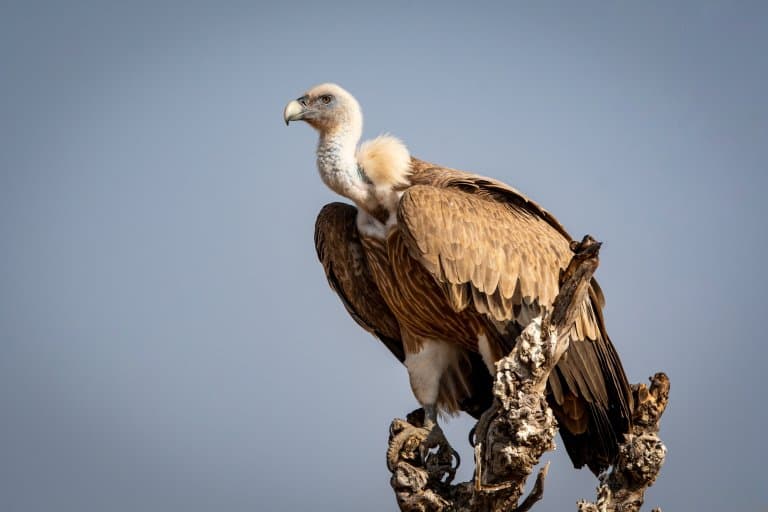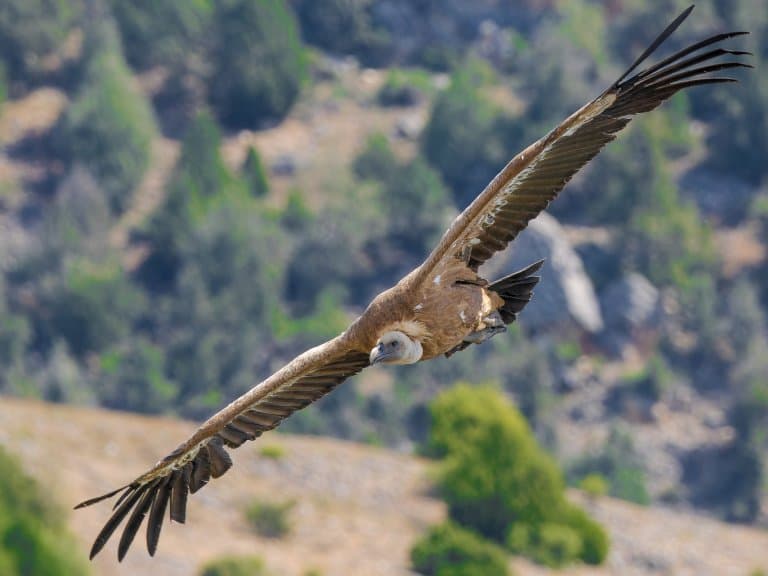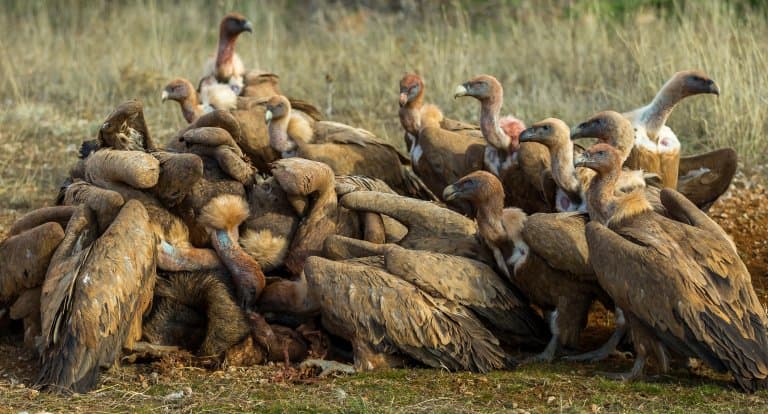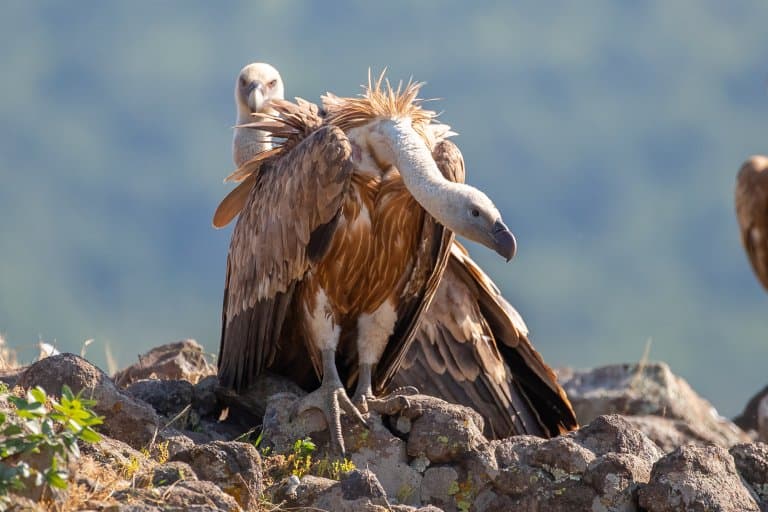Eurasian Griffon Vulture Profile
Vultures are commonly associated with the African plains, but they were once prevalent on the European continent too. Vast numbers of enormous birds would circle at high altitudes, scanning the earth for corpses.
Most of the vultures in Europe were persecuted by humans under the misconception that they’d steal livestock, and while some are making a comeback thanks to conservation efforts, African species are now following suit. The Griffon vulture is one of the largest flying birds, and it’s also one of the most endangered in Africa.

Eurasian Griffon Vulture Facts Overview
| Habitat: | Cliffs, gorges, lowland terraces, savanna, woodlands, grasslands |
| Location: | Spain, Portugal, France, Italy, Croatia, Greece, Bulgaria, Serbia, Greece, North Macedonia |
| Lifespan: | Up to 50 years |
| Size: | 110cm (3’5”) tall, 2.8m (9.2ft) wingspan |
| Weight: | Up to 11kg |
| Colour: | Brown body, white head, neck, and ruff |
| Diet: | Carrion of large domestic and wild herbivores |
| Predators: | Humans |
| Top Speed: | Not known |
| No. of Species: | 1 |
| Conservation Status: | Least concern (IUCN) |
Griffon vultures are one of eight species in their genus.
Alongside the Eurasian griffon vulture, often referred to simply as the ‘griffon vulture’, there is – the White-rumped vulture, Cape vulture, Indian vulture, Slender-billed vulture, Rüppell’s vulture, White-backed vulture and Himalayan vulture.
The Eurasian griffon vulture is the most successful of the eight, after receiving a lot of attention from conservation drives, but they also hold the template for the decline of their cousins.
They form loose colonies, breeding on crags in mountains in southern Europe, north Africa, and Asia and use the termals to travel huge distances in search of carrion.
If their sad history of persecution isn’t enough to protect their cousins, perhaps the success of their recovery will be.
Interesting Eurasian Griffon Vulture Facts
1. They have a winspan over 2m!
The griffon vulture is a very large bird of prey. They can measure between 93–122 cm (37–48 in) in length and have a wingspan up to 2.8m (9.2 ft).
They often weigh up to 11kg, but some extreme weights of up to 15kg have been reported in captivity.

2. They’re recyclers
It’s easy to associate carrion feeders with filth and disease; lowly animals that flock to eat what everything else has discarded. But this is only half true. The very nature of these scavengers makes them critically important in several ways.
Firstly, hoovering up rotting flesh is a much better idea than leaving it lying around, especially in terms of disease. But this waste doesn’t go to waste, either.
The nutrients stored in the dead animal’s flesh are then put back into the soil when the vulture poops it back out again, fuelling the next generation of plants and microbes at the base of the food chain.
So, in this regard, they’re both ecosystem engineers and hygiene specialists. And an animal as large as a griffon vulture can get through a lot of recycling.
3. But their ability to remove diseases really stands out
So, while their habit of digging under the skin of a corpse with their face does sort of suggest a lack of hygiene, these birds are able to ingest all kinds of potentially hazardous pathogens.
Griffon vultures have been found capable of slurping up some terrifying bacteria such as anthrax, botulism, and cholera.
As a result of evolving to eat such rotten and disgusting stuff, they’ve developed a remarkable tolerance to these diseases, and help to remove them from circulation.
But more than this, they could potentially be used to map disease outbreaks or areas of high risk. 1

4. They rely on the sun to fly
Their size is both an advantage and a disadvantage to their ability to travel. Griffon vultures are experts at long-range, high-altitude gliding. They can spend hours riding thermal currents, barely needing to move their wings to stay aloft.
But, they have to get up there. An 11kg bird is not an easy thing to lift, even with wings, so griffon vultures wait for the later part of the morning when the sun is in full swing. Using the reflected heat of the mid-morning sun, they’re able to get airborne with surprising ease.
And once they’re up there, they’ll ride up to 6km high! And they can stay up there for hours. They’ll use this method to scan the ground for corpses, which they do with exceptional eyesight and across distances of up to 300km per day.
But they’re also capable of long migrations and have been tracked crossing six countries and three continents on their search for a place to call home or in some cases to simply spend Winter before heading back again. They tend to do more of this while they’re maturing: up to around five years old. 2 3
5. They’re good parents
But the nomadic nature of young griffon vultures isn’t any slight on their parents.
Both adults in a breeding pair will incubate a single egg, and this process will go on for almost two months before the juvenile hatches.
Then, they’re fed, again by both parents, until they’re around four months old, at which time they’ll start to become independent, but will still receive care from both their parents for another three months!
This intensive parental care takes place in large, social breeding colonies in which multiple breeding pairs look out for one another. In Europe, these social birds make up one of the largest populations of vultures, with over 35,000 individuals.
6. Their cousins are following a similar course
While the Eurasian Griffon vulture, Gyps fulvus, is extinct only in a small portion of its previous range – mostly Southern Europe – it’s doing very well. It’s thought that there are close to a million individuals spread out over three continents, and populations are increasing.
Unfortunately, the same cannot be said for other members of the genus, particularly the African resident, Gyps rueppelli, or the Rüppel’s vulture.
22,000 mature individuals occupy territories spanning the uppermost range of Subsaharan Africa, and numbers are dropping.
And this is something that the Griffon vulture knows only too well. As Africa develops and the human population explodes, more wild land is converted to pasture. This causes a double blow to vultures, as it reduces the amount of carrion from wild ungulates like gazelles while at the same time putting the vultures into conflict with humans.
And history repeats itself. While vultures do occasionally hunt, they’re generally carrion feeders, but this doesn’t protect them from the wrath of a farmer protecting their livestock. In many places, poison is used to kill off raptors and other perceived threats.
But poisonings are often accidental too. Pesticides used on crops make their way into vulture populations, as do anti-inflammatory and antibiotic drugs, some of which can be toxic to birds.
Diclofenac is a famous example of a drug marketed and used as an aid to livestock that happens to be fatal to Gyps spp.
The Griffon vulture is now doing well in Europe, but that’s only as a result of a concentrated conservation effort. Before that, they had been reduced in much the same way as the birds in Africa are now. 4
7. The Vulture Conservation Foundation is helping
VCF striving to return healthy populations of the historically persecuted vulture species to their native European habitat, and they’re bringing other species along for the ride.
A Ruppel’s vulture released in Portugal immediately flew to The Gambia and back. While populations in Africa are decreasing, they seem to be increasing in Europe, likely due to more choosing to stay put for longer as climate change raises the Winter temperatures.
But it’s also thought that they might be hanging out more with the griffons, who may be bringing them back to the European continent as visitors.
The VCF is monitoring and supporting breeding pairs in Morrocco and has its eyes on 36,000 breeding pairs in Spain.

Eurasian Griffon Vulture Fact-File Summary
Scientific Classification
| Kingdom: | Animalia |
| Phylum: | Chordata |
| Class: | Aves |
| Order: | Accipitriformes |
| Family: | Accipitridae |
| Genus: | Gyps |
| Species: | Gyps Fulvus |
Fact Sources & References
- “Anthrax Epidemiology and Vultures”, Smithsonian’s National Zoo & Conservation Biology Institute.
- (2016), “Bulgarian griffon vulture explores Middle East”, Rewilding Europe.
- “Griffon Vulture, Gyps fulvus”, Rancho Texas Lazarote Park.
- “Rüppell’s Vulture”, IUCN.
